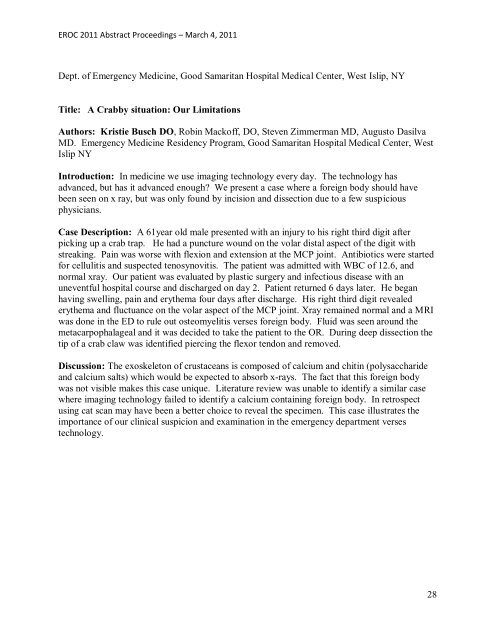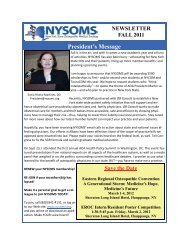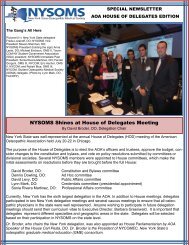Abstract Proceedings EROC 2011 - New York Osteopathic Medical ...
Abstract Proceedings EROC 2011 - New York Osteopathic Medical ...
Abstract Proceedings EROC 2011 - New York Osteopathic Medical ...
You also want an ePaper? Increase the reach of your titles
YUMPU automatically turns print PDFs into web optimized ePapers that Google loves.
<strong>EROC</strong> <strong>2011</strong> <strong>Abstract</strong> <strong>Proceedings</strong> – March 4, <strong>2011</strong><br />
Dept. of Emergency Medicine, Good Samaritan Hospital <strong>Medical</strong> Center, West Islip, NY<br />
Title: A Crabby situation: Our Limitations<br />
Authors: Kristie Busch DO, Robin Mackoff, DO, Steven Zimmerman MD, Augusto Dasilva<br />
MD. Emergency Medicine Residency Program, Good Samaritan Hospital <strong>Medical</strong> Center, West<br />
Islip NY<br />
Introduction: In medicine we use imaging technology every day. The technology has<br />
advanced, but has it advanced enough? We present a case where a foreign body should have<br />
been seen on x ray, but was only found by incision and dissection due to a few suspicious<br />
physicians.<br />
Case Description: A 61year old male presented with an injury to his right third digit after<br />
picking up a crab trap. He had a puncture wound on the volar distal aspect of the digit with<br />
streaking. Pain was worse with flexion and extension at the MCP joint. Antibiotics were started<br />
for cellulitis and suspected tenosynovitis. The patient was admitted with WBC of 12.6, and<br />
normal xray. Our patient was evaluated by plastic surgery and infectious disease with an<br />
uneventful hospital course and discharged on day 2. Patient returned 6 days later. He began<br />
having swelling, pain and erythema four days after discharge. His right third digit revealed<br />
erythema and fluctuance on the volar aspect of the MCP joint. Xray remained normal and a MRI<br />
was done in the ED to rule out osteomyelitis verses foreign body. Fluid was seen around the<br />
metacarpophalageal and it was decided to take the patient to the OR. During deep dissection the<br />
tip of a crab claw was identified piercing the flexor tendon and removed.<br />
Discussion: The exoskeleton of crustaceans is composed of calcium and chitin (polysaccharide<br />
and calcium salts) which would be expected to absorb x-rays. The fact that this foreign body<br />
was not visible makes this case unique. Literature review was unable to identify a similar case<br />
where imaging technology failed to identify a calcium containing foreign body. In retrospect<br />
using cat scan may have been a better choice to reveal the specimen. This case illustrates the<br />
importance of our clinical suspicion and examination in the emergency department verses<br />
technology.<br />
28











